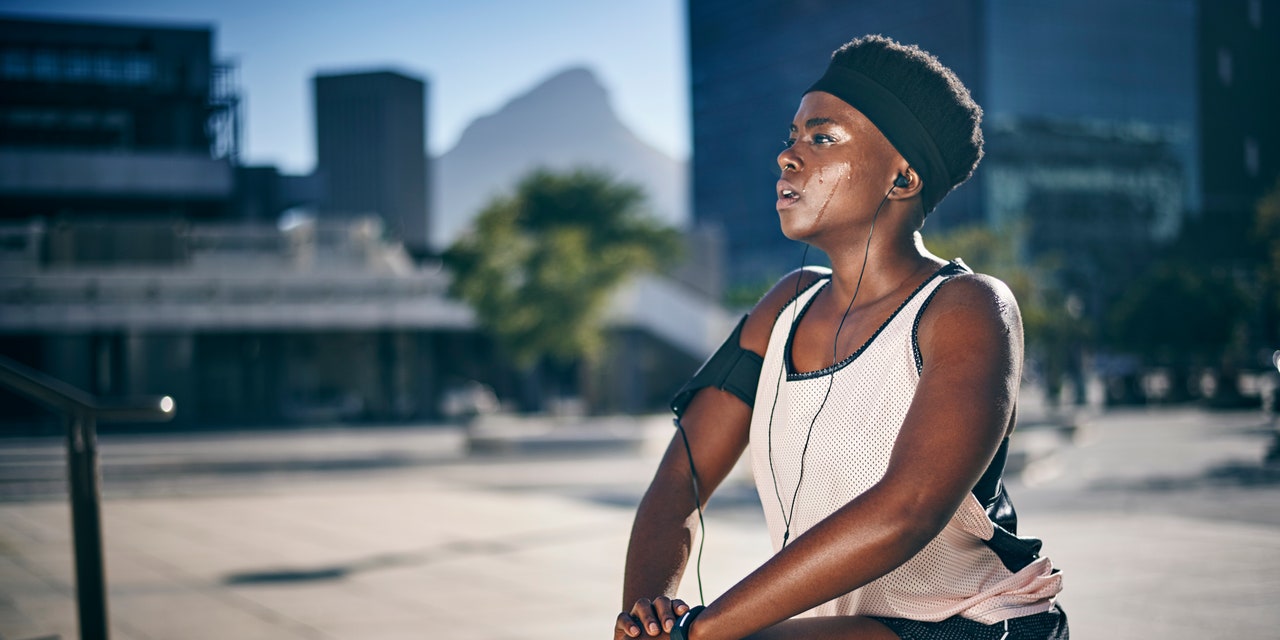How to Make Exercising Outside in Hot Weather Feel a Little Less Miserable

Over that period of time, with regular exposure, physiological changes occur that help your body better deal with heat stress. For example, you get sweatier faster—and the evaporation of that liquid off your skin allows for better cooling. Other indications include your skin and core temperature staying lower and your heart rate and blood flow more stable.
All this means easing into exercise in hot weather is important, Seely says; she wouldn’t have attempted a tough interval workout at the beginning of summer.
Whatever your regular routine is, take a couple steps back the first few times you work out in the heat, Seely suggests. Go for less time, fewer miles, or a lower intensity (maybe more walking instead of running, for instance). Over a period of a week or two, you’ll likely start to notice things feel easier, and you can start to ramp back up again—gradually.
However, even after you’re acclimated, any given workout will likely still feel harder in the heat, Kylee Van Horn, RD, a registered dietitian, certified running coach, and ultrarunner in Carbondale, Colorado, tells SELF. That isn’t necessarily bad, just something to keep in mind—so adjust your expectations and don’t get hung up on hitting the same times or paces you might be able to in cooler weather. Finally, if you still want to go super hard and it’s super hot outside, take your workout indoors.
2. Get hot when you’re not exercising.
Though it might seem counterintuitive, you can accelerate the acclimation process by spending time between workouts sweating too. In a University of Birmingham study, researchers asked 20 trained runners to hop in the sauna for 30 minutes after an easy run. After three weeks, they were more tolerant of the heat, as measured by their core body temperature and heart rate in warm workouts—and what’s more, they ran faster in more moderate weather conditions.
When she was preparing for the Speed Project in 2021—a 300-plus-mile run from Los Angeles to Las Vegas—ultrarunner Jes Woods used this method, adding 30 minutes in a sauna after each day’s run for a 10-day period. And Adidas Terrex athlete and ultrarunner Abby Hall hits the sauna for 20 to 30 minutes in the final weeks before a big event like the Western States 100 (a 100.2-mile event with temps that hit over 100 degrees) or a Fastest Known Time race in Death Valley.
No access to a sauna? Simply sitting in a steaming bath can work as well, says Woods. However, as Howard points out, research suggests the water needs to be about 104 degrees—a temperature that might be hard to maintain for the necessary 20 to 40 minutes. (Plus, the water temperature shouldn’t go hotter than that, according to the CDC.)
That’s not to say, though, that you can’t reap some benefits without going super intense with it. Simply spending 60 to 90 minutes in the heat doing some physical activity that’s not as strenuous as your regular exercise (say, going for a walk) might also stimulate some similar physiological changes. And just sitting outside with a book or a smoothie could be beneficial, too, by helping shift your mindset. “Sitting in [high temperatures] will likely give you more mental wherewithal to endure and enjoy than any actual physical adaptation—but mental resilience is very important too,” Howard says.
3. Hydrate, hydrate, hydrate—before your workout even starts.
Preparation is key to hydration in the heat, hiker Natalie Smart, owner of a travel business called Destination Hike, tells SELF. While hydration during each hike is essential—she advises attendees of her treks to bring two liters of water to every hot-weather adventure, regardless of distance—it’s not something you can cram for. Instead, get a jump-start by staying on top of your fluids beforehand. “People don’t realize it’s the day before that can either set you up for success or failure,” she says.





